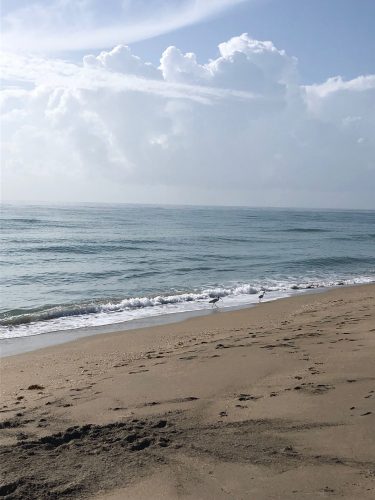 Editor’s note: This post was originally published on July 9, 2019.
Editor’s note: This post was originally published on July 9, 2019.
Spending time at the beach is a great way to capitalize on the beauty, fun, and health benefits of nature. While seaside recreation can feel refreshing, relaxing, and even spiritual — our activities can have destructive effects on marine environments.
One human impact gaining attention recently is the negative effect certain sunscreen chemicals can have on coral reef habitats. As a huge fan of snorkeling and a big loather of skin cancer, this news is heartbreaking to me. Accordingly, this month I decided to learn what I can do to protect myself from the sun while minimizing my impact on corals and other marine life.
Let me start by saying the effects of prolonged sun exposure are no joke. Skin damage from the sun can occur in as little as 15 minutes, and skin cancer is the most common cancer in the United States. And then there are the vanity considerations. Pigment changes, wrinkles, and other expedited aging signs can all be tough on our self-esteem. Sun protection should be a priority for everyone; only the methods of sun protection need reconsideration.
I began my investigation by reviewing the National Oceanic and Atmospheric Administration’s online explainer: Skincare Chemicals and Coral Reefs. While I had been aware that sunscreens may contain ingredients harmful to coral, I had many misconceptions about the extent and depth of the problem. Here are some of the big things I learned.
It’s not just one chemical compound that can have negative impacts on marine life.
Actually, NOAA lists ten chemicals/minerals that are known to have adverse effects on marine ecosystems. These include the (not so) easy to remember:
- Oxybenzone
- Octinoxate
- Octocrylene
- Benzophenone-1
- Benzophenone-8
- OD-PABA
- 4-Methylbenzylidene camphor
- 3-Benzylidene camphor
- Nano Titanium Dioxide
- Nano Zinc Oxide
Corals are just one example of the marine life affected.
While not all of the harmful chemicals produce the same effects, here is a quick summary of marine life at risk from the compounds listed above:
- Corals- increased susceptibility to bleaching, DNA mutations, abnormal skeleton growth, death and deformity of young coral
- Mussels- defects in young
- Dolphins- accumulation in tissues which can be passed on to young
- Fish- decreased fertility, males exhibiting female characteristics
- Sea Urchins- damage to immune and reproductive systems, deformity of young
- Green Algae- impaired growth and photosynthesis
Sunscreens containing the harmful chemicals are not just a problem at the beach, but everywhere.
Showering and/or bathing cause the chemicals to enter wastewater streams, many of which ultimately enter our waterways.
Sunscreens aren’t the only product that contains these chemicals.
Real bad news here. NOAA suggests the above chemicals are found in “thousands of products” including soaps, cosmetics, fragrances, and sunscreens.
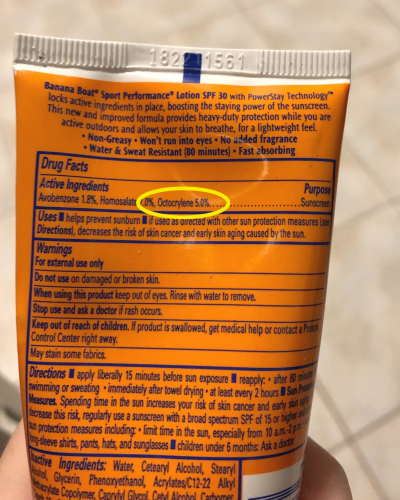
Armed with this updated information, it was time to go through my products and assess the damage. First up, my daily moisturizer. I make it a point to put on some SPF every morning, so it’s important that I use a product that is reef-safe. Unfortunately, my current regimen contains both octinoxate and octocrylene and will need to be replaced.
Next, I looked at the body sunscreen I use for outdoor recreation. Again, octocrylene was the guilty party. Finally, I looked through my other cosmetics and soaps. Fortunately, these products did not contain any of the chemicals listed by NOAA. Still, it appeared that I had some shopping to do!
So, what should I look for in a new, marine life-friendly sunscreen?
I found several recommendations from the Surfrider Foundation, a non-profit environmental organization dedicated to marine protection.
Here is what to look for:
- First, look at the active ingredients and avoid products with the dangerous chemicals listed above. Mineral-based sunscreens can be a better alternative, featuring active ingredients like zinc oxide and titanium dioxide. Importantly, steer clear of the nano-sized versions of these mineral compounds if you can. Apparently labeling rules make this determination somewhat challenging, so your best bets are products that explicitly declare they contain non-nano zinc oxide or non-nano titanium dioxide.
- Next, stick with lotion-like products rather than sprays, as titanium dioxide can harm human health when inhaled. I imagine using lotions also cuts down on waste, as I’ve found that spray sunscreens tend to run out pretty quickly.
- Continuing the theme of waste, look for products that come in biodegradable or recyclable containers, or whose containers were made using recyclable materials. This ultimately cuts down on the pollution of single-use plastics in the ocean, a separate but related marine health issue.
I started my reef-safe sunscreen shopping endeavor online, but quickly became overwhelmed. There are lots of lists ranking various brands, and even more reviews for each product. In the end, I opted to visit CVS and see what reef-safe products were available in-store.
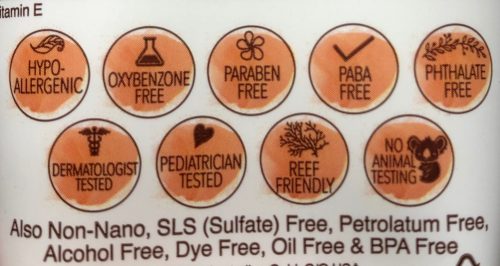
While there weren’t dozens of options, there were a handful of brands to choose from. I selected a lotion-based product with non-nano titanium dioxide and zinc oxide as the active ingredients. The product also marketed itself as hypoallergenic and pediatrician tested, which I assume means it’s safe for kids.
Though my new sunscreen marketed itself as reef-safe, studies into the impacts of sunscreens on ocean life are ongoing and future results may suggest that even mineral sunscreens have undesirable effects on marine life. As a result, it’s important to not only switch to more reef-friendly sunscreens, but to greatly reduce sunscreen use overall. To accomplish this, NOAA recommends limiting sun exposure between 10:00 am and 2:00 pm, when UV rays are strongest. If you must be in the sun, wear sun protective clothing like a broad-brimmed hat, sunglasses, a long-sleeved shirt, and pants. You then would only need to apply sunscreen to remaining exposed areas like your face and hands.

I used this strategy last year when I spent a week in the Nebraska Badlands collecting fossils, and honestly, I loved it. I have fair skin that burns easily, and it was a huge relief to not have to constantly worry about reapplying sunscreen.
My next goal is to do a better job of covering up while at the beach. There is a lot of social pressure to sport a fun swimsuit and tan, particularly for women. While I gave up intentionally tanning years ago, I haven’t taken great pains to avoid tan lines either. This summer I’m aiming to wear more protective clothing during times of high sun, and to make better use of our beach umbrella.
I got the opportunity to test out all of these strategies over July 4th weekend while spending time near the beach on Hutchinson Island.
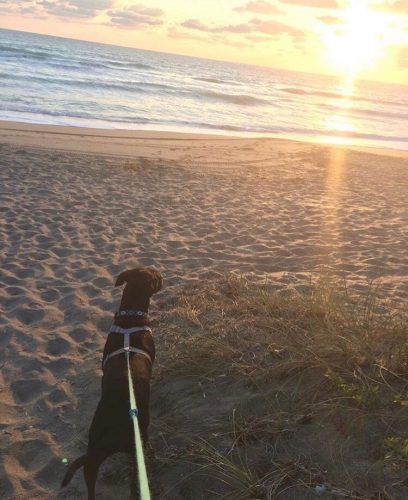
My first goal was to spend less time on the beach between 10:00 am and 2:00 pm. This turned out to be super easy, because it was so, so hot outside, even with the beach breeze. When I walked the dog on the beach in the morning, I sported sunglasses and a wide-brim hat to minimize sun exposure on my face.
I did go swimming one afternoon, which gave me the opportunity to try out the new sunscreen on a large scale. I actually made my entire beach-going party try it out, too—for science!
The sunscreen smelled great, was not greasy at all, and was mostly easy to rub in. And the most important part—no sunburns all around! My legs did end up with a white-ish residue that was a little bit of work to remove later in the shower, and my black swimsuit did get some temporary white marks as well. Neither of these are deal-breakers for me, and overall I felt my reef-friendly sun protection experiment was a great success. I plan to keep using the reef-friendly sunscreen I purchased, but will also continue to reduce my time in the sun and increase my clothing protection.
I do want to quickly note that solutions are complicated, and even choosing sun protective clothing requires some dedicated thought. Though I haven’t addressed it here, I look forward to exploring sustainable fabrics and the impacts of plastic microfibers in a future Action of the Month.
Until then, here’s to a sun-safe and marine life-friendly summer!
Resources:
NOAA: Skincare Chemicals and Coral Reefs
CDC: Basic Information about Skin Cancer
Surfrider Foundation: Your Guide to Reef Friendly Sunscreens
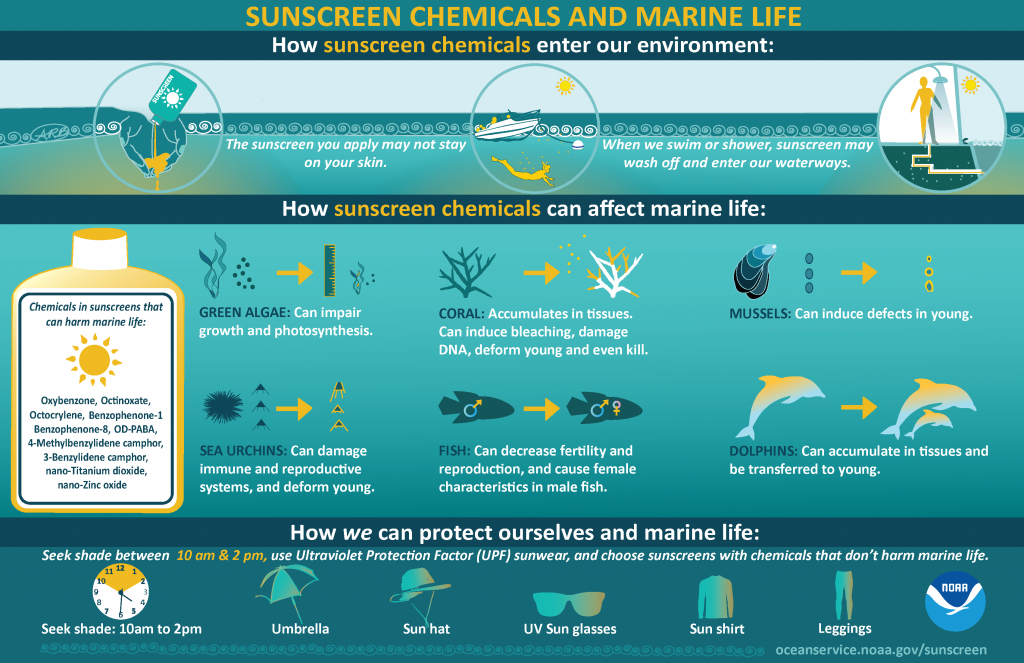
About the Author
 Sadie Mills is a coordinator and environmental educator for TESI. She manages programs and events that support TESI’s mission of educating Floridians about the state’s natural systems and the threats they face.
Sadie Mills is a coordinator and environmental educator for TESI. She manages programs and events that support TESI’s mission of educating Floridians about the state’s natural systems and the threats they face.